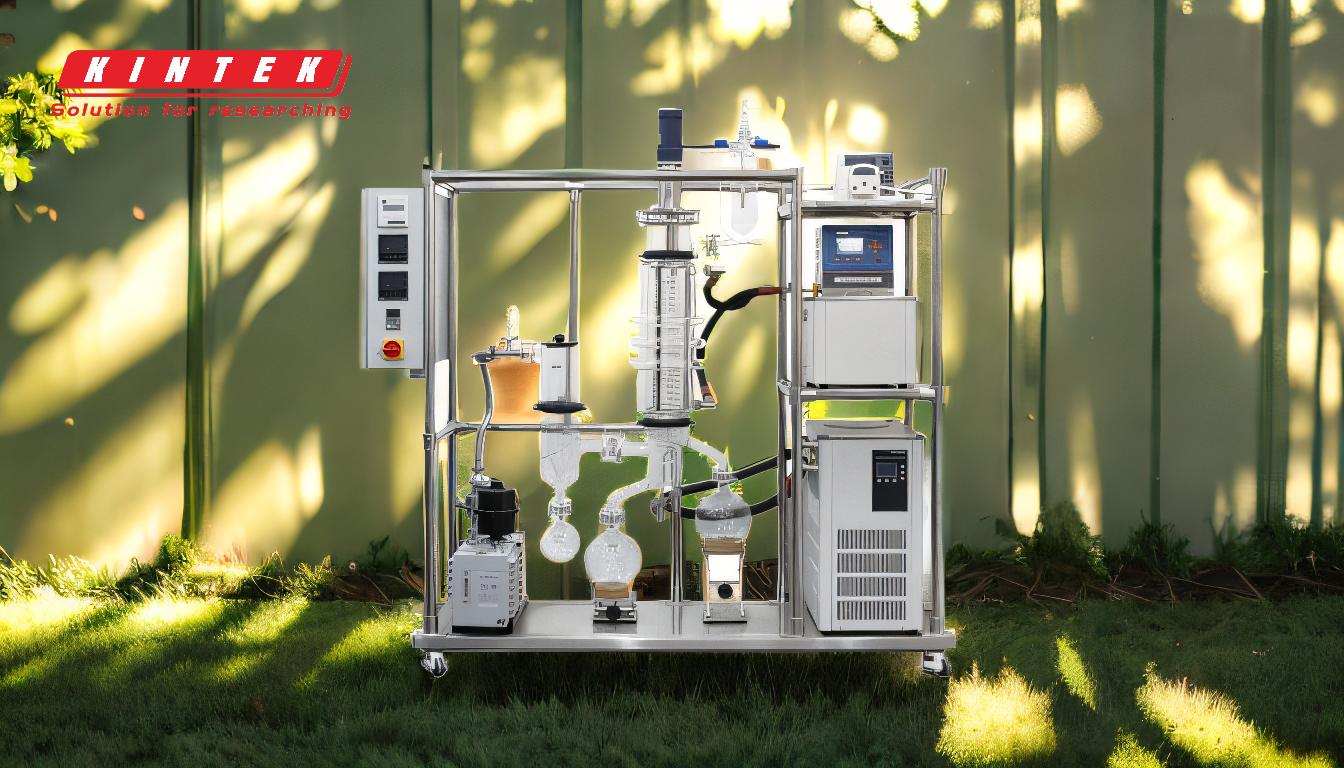Vacuum distillation of ethanol is a specialized technique used to purify ethanol by lowering the pressure in the distillation apparatus, which reduces its boiling point. This method is particularly useful for separating ethanol from mixtures or isolating high-purity ethanol without exposing it to high temperatures that could cause decomposition or degradation. By operating under reduced pressure, vacuum distillation minimizes thermal stress on the ethanol, preserving its chemical integrity and ensuring a high-purity distillate. This process is widely used in industries such as pharmaceuticals, food and beverage, and chemical manufacturing, where high-purity ethanol is essential.
Key Points Explained:

-
Definition and Purpose of Vacuum Distillation:
- Vacuum distillation is a separation technique used to purify liquids with high boiling points or those that are heat-sensitive.
- For ethanol, this process allows it to be distilled at lower temperatures by reducing the pressure, preventing thermal decomposition and maintaining its purity.
-
How Vacuum Distillation Works:
- Pressure Reduction: The pressure inside the distillation apparatus is lowered below atmospheric pressure.
- Lower Boiling Point: As pressure decreases, the boiling point of ethanol also decreases. For example, ethanol, which normally boils at 78.37°C at atmospheric pressure, can boil at a much lower temperature under vacuum.
- Vaporization and Condensation: Ethanol vaporizes when its vapor pressure equals the surrounding pressure. The vapor is then condensed back into a liquid and collected as the distillate.
-
Advantages of Vacuum Distillation for Ethanol:
- Preservation of Chemical Integrity: Lower temperatures prevent ethanol from decomposing or oxidizing, which is crucial for producing high-purity ethanol.
- Energy Efficiency: Distilling at lower temperatures reduces energy consumption compared to atmospheric distillation.
- High-Purity Output: The process yields ethanol with minimal impurities, making it suitable for sensitive applications like pharmaceuticals and laboratory use.
-
Applications of Vacuum-Distilled Ethanol:
- Pharmaceuticals: High-purity ethanol is used as a solvent or reagent in drug manufacturing.
- Food and Beverage: Ethanol is used in the production of alcoholic beverages and food flavorings, where purity is critical.
- Chemical Industry: Ethanol serves as a solvent or intermediate in chemical synthesis.
- Laboratory Use: High-purity ethanol is essential for analytical and research purposes.
-
Equipment and Setup for Vacuum Distillation:
- Distillation Flask: Holds the ethanol mixture to be distilled.
- Vacuum Pump: Reduces the pressure inside the system.
- Condenser: Cools the ethanol vapor back into a liquid.
- Collection Flask: Collects the distilled ethanol.
- Pressure Gauge: Monitors the pressure inside the system to ensure optimal conditions.
-
Key Considerations for Vacuum Distillation of Ethanol:
- Pressure Control: Precise control of pressure is necessary to achieve the desired boiling point and distillation efficiency.
- Temperature Monitoring: Even at lower temperatures, overheating must be avoided to prevent ethanol degradation.
- Safety Measures: Proper sealing of the apparatus is essential to maintain the vacuum and prevent leaks.
-
Comparison with Atmospheric Distillation:
- Temperature: Vacuum distillation operates at lower temperatures, reducing the risk of thermal decomposition.
- Purity: Vacuum distillation typically yields higher-purity ethanol compared to atmospheric distillation.
- Energy Use: Vacuum distillation is more energy-efficient for heat-sensitive compounds like ethanol.
-
Challenges and Limitations:
- Equipment Cost: Vacuum distillation systems are more complex and expensive than atmospheric distillation setups.
- Operational Complexity: The process requires careful control of pressure and temperature, making it more technically demanding.
- Maintenance: Regular maintenance of the vacuum pump and seals is necessary to ensure consistent performance.
By understanding these key points, a purchaser of equipment or consumables can make informed decisions about implementing vacuum distillation for ethanol purification, ensuring optimal results for their specific application.
Summary Table:
| Aspect | Details |
|---|---|
| Purpose | Purify ethanol at lower temperatures to prevent decomposition. |
| Key Benefits | - Preserves chemical integrity - Energy-efficient - High-purity output |
| Applications | Pharmaceuticals, food & beverage, chemical industry, laboratory use. |
| Equipment | Distillation flask, vacuum pump, condenser, collection flask, pressure gauge. |
| Challenges | Higher equipment cost, operational complexity, and maintenance requirements. |
Ready to implement vacuum distillation for your ethanol purification needs? Contact us today for expert guidance and solutions!













